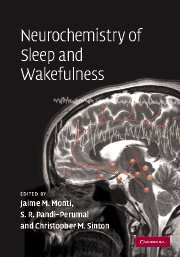Book contents
- Frontmatter
- Contents
- List of contributors
- Preface
- Acknowledgements
- Abbreviations
- I The neurochemistry of the states of sleep and wakefulness
- II The influence of neurotransmitters on sleep and wakefulness
- III Changing perspectives
- 10 Melatonin and its receptors: biological function in circadian sleep–wake regulation
- 11 Sleep regulatory factors
- 12 Adenosine and sleep–wake regulation
- 13 Prostaglandins and the regulation of sleep and wakefulness
- 14 Neuropeptides and sleep–wake regulation
- 15 Orexins in sleep and wakefulness: rodent models of narcolepsy–cataplexy
- 16 The relevance of experimental pharmacology to currently available sleep–wake therapeutics
- Index
- Plate section
14 - Neuropeptides and sleep–wake regulation
from III - Changing perspectives
Published online by Cambridge University Press: 23 October 2009
- Frontmatter
- Contents
- List of contributors
- Preface
- Acknowledgements
- Abbreviations
- I The neurochemistry of the states of sleep and wakefulness
- II The influence of neurotransmitters on sleep and wakefulness
- III Changing perspectives
- 10 Melatonin and its receptors: biological function in circadian sleep–wake regulation
- 11 Sleep regulatory factors
- 12 Adenosine and sleep–wake regulation
- 13 Prostaglandins and the regulation of sleep and wakefulness
- 14 Neuropeptides and sleep–wake regulation
- 15 Orexins in sleep and wakefulness: rodent models of narcolepsy–cataplexy
- 16 The relevance of experimental pharmacology to currently available sleep–wake therapeutics
- Index
- Plate section
Summary
Introduction
The importance of peptide transmitters in the modulation of sleep and wakefulness has become apparent in recent years. Previous work had focused on the role of monoamines in the circuitry that regulates the transitions between states of vigilance. Histaminergic neurons in the tuberomammillary nucleus are known to be key players in the activation of subcortical afferents during wakefulness (Wada et al., 1991). Activity of noradrenergic neurons in the locus coeruleus correlates with the state of vigilance (Jones, 1991). The role of serotonergic neurons in rapid eye movement (REM) sleep has also been established (Lydic et al., 1987; Monti & Jantos, 1992; Fabre et al., 2000).
In spite of major advances in our understanding of the neuronal circuits that govern the sleep–wakefulness cycle (Pace-Schott & Hobson, 2002), the cell groups involved in the coordination of the different stages of sleep and in the control of the boundaries between sleep states are poorly understood. The development of molecular markers that define neuronal cell groups with distinct physiological properties is expected to enhance our understanding of the regulation of the states of vigilance.
With this in mind, the search for molecular markers that define populations of neurons in areas important for arousal is clearly warranted.
- Type
- Chapter
- Information
- Neurochemistry of Sleep and Wakefulness , pp. 387 - 401Publisher: Cambridge University PressPrint publication year: 2008
- 1
- Cited by



